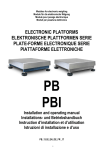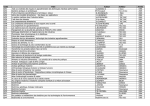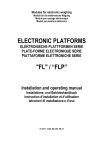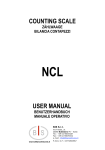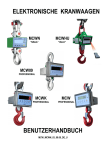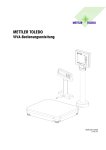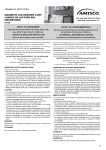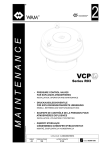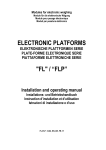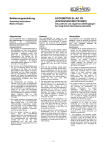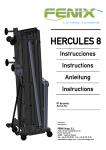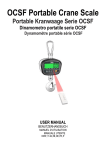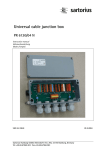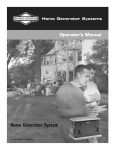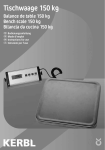Download 0 … 9 - BilanceOnLine
Transcript
PRICE COMPUTING SCALE PREISRECHNENDE WAAGE BALANCE POIDS / PRIX BILANCIA PESO / PREZZO NPS USER MANUAL BENUTZERHANDBUCH MODE D’EMPLOI OPERATEUR MANUALE UTENTE BIS S.r.l. Via Trieste, 31 20080 Bubbiano MI – Italia Tel.: +39 02 90834207 Fax: +39 02 90870542 e-mail: [email protected] NPS_01_13.11_EN_DE_FR_IT www.BilanceOnLine.it P.IVA e C.F.: 03774900967 LANGUAGES SPRACHEN LANGUES LINGUE ENGLISH ................................................................................................................. 3 DEUTSCH .............................................................................................................. 13 FRANÇAIS ............................................................................................................. 24 ITALIANO ............................................................................................................... 35 2 ENGLISH INDEX 1. INTRODUCTION .................................................................................................................................................................. 4 2. MAIN TECHNICAL SPECIFICATIONS ................................................................................................................................ 4 3. INSTALLATION ................................................................................................................................................................... 4 3.1 POWER SUPPLY AND START-UP ............................................................................................................................. 5 3.2 BATTERY POWERED ................................................................................................................................................ 5 4. FRONT PANEL KEYS AND INDICATORS ......................................................................................................................... 5 4.1 FUNCTION OF THE KEYS ......................................................................................................................................... 6 4.2 FUNCTION OF THE INDICATORS ............................................................................................................................. 6 5. OPERATION ........................................................................................................................................................................ 6 5.1 AUTOMATIC ZERO UPON START-UP ....................................................................................................................... 6 5.2 SCALE ZERO FUNCTION .......................................................................................................................................... 6 5.3 TARE FUNCTION ....................................................................................................................................................... 7 5.4 OVERLOAD MESSAGE.............................................................................................................................................. 7 5.5 UNIT PRICE SETTING ............................................................................................................................................... 7 5.6 UNIT OF MEASURE SETTING KILOGRAMS / POUNDS .......................................................................................... 7 5.7 PRINTING AND TOTALISATION OF THE AMOUNT .................................................................................................. 7 5.8 DISPLAY BACKLIGHT ................................................................................................................................................ 8 6. SET-UP ................................................................................................................................................................................ 8 6.1 SCALE MINIMUM DIVISION....................................................................................................................................... 8 6.2 ZERO TRACKING ....................................................................................................................................................... 8 6.3 AMOUNT ROUNDING ................................................................................................................................................ 8 6.4 NUMBER OF AMOUNT DECIMALS ........................................................................................................................... 8 7. CALIBRATION WITH ZERO ACQUISITION AND CAPACITY SELECTION ...................................................................... 8 8. GRAVITY OF CALIBRATION AND USE ZONES ................................................................................................................ 9 9. SERIAL OUTPUT................................................................................................................................................................. 9 9.1 SETTINGS .................................................................................................................................................................. 9 9.2 OUTPUT DATA FORMAT .......................................................................................................................................... 10 9.3 PRINTER CONNECTION ......................................................................................................................................... 10 10. SEALING ACCESS TO THE BALANCE SETTINGS ...................................................................................................... 11 11. MESSAGES ..................................................................................................................................................................... 11 RECYCLING INSTRUCTION ................................................................................................................................................. 12 DECLARATION OF CONFORMITY ...................................................................................................................................... 12 WARRANTY .......................................................................................................................................................................... 12 3 1. INTRODUCTION This manual was created to help you install and learn all about the functional possibilities of the NPS scale. WARNINGS The scales should be sited in a location that will not degrade the accuracy. Avoid extremes of temperature. Do not place in direct sunlight or near air conditioning vents. Avoid unsuitable tables. The tables or floor must be rigid and not vibrate. Do not place near vibrating machinery. Avoid unstable power sources. Do not use near large users of electricity such as welding equipment or large motors. Avoid high humidity that might cause condensation. Avoid direct contact with water. Do not spray or immerse the scales in water. Avoid air movement such as from fans or opening doors. Do not place near open windows. Keep the scales clean. Do not stack material on the scales when they are not in use. 2. MAIN TECHNICAL SPECIFICATIONS Model NPS3K NPS6K NPS15K NPS30K Plate (dimensions in mm) 218x267 218x267 218x267 218x267 Operative Temperature: Relative humidity: Power supply: Zero range: Auto zero at start-up: Capacity kg Standard Division g 1 2 5 10 3 6 15 30 CE-M Division g 1 2 5 10 0°C - 40°C / 32°F - 104°F. ≤ 85 % RH AC 240V (±10%) / 50 Hz, 110V/60HZ DC 4V / 4Ah with rechargeable accumulator inside. +/- 2% of max load capacity. +/- 10% of max load capacity. 3. INSTALLATION a) Unpack then product. b) Level the platform by adjusting the adjustable feet until the bubble is in the centre of the level. The stability of the platform is very important. ALL THE CORNERS MUST REST IN A UNIFORM WAY. Carefully check that all feet fully rest on the ground and that the platform, loaded on the corner, is not unstable (if a corner is not resting on the ground its relative foot is easier to turn). 4 3.1 POWER SUPPLY AND START-UP The indicator can be powered with a fitted external power adapter or just with the fitted battery. NOTE: it is advisable to completely recharge the battery (12 hours) with the first installation of the instrument. TO POWER the instrument through the 240 Vac mains put the AC/DC power plug in the appropriate socket under the scale and the power adapter in the 240 Vac mains socket. TO TURN ON/TURN OFF the instrument, press the C-On/Off key at length. The display shows: UL569 XX_X is the name of the model: "NPS". 01.YY is the installed software version. The indicator has an “auto zero at start-up” function: in other words it means that if at start-up a weight within +/- 10% of the capacity is detected, it will be zeroed; if the weight is not within this tolerance, with a non approved instrument the display shows the present weight after a few instants, while with an approved instrument “ZerO” is shown continuously on the display, until the weight does not re-enter within this tolerance. After this, it shows “hi rES” (in case of NOT approved instrument) or “LEGAL” (in case of approved instrument). 3.2 BATTERY POWERED The weighing indicator can be operated from the battery if desired. When the battery needs charging the “- LO -” message on the display appears. The battery should be charged when the message appears. The scale will still operate for some minutes after which it will automatically switch off to protect the battery. To charge the battery simply plug into the mains power. The scale does not need to be turned on. The battery should be charged for 12 hours for full capacity. One can find the “- - AC - -” message on the PCS display to indicate the status of battery charging. When the scale is plugged into the mains power the internal battery will be charged. As the battery is used it may fail to hold a full charge. If the battery life becomes unacceptable then contact your distributor 4. FRONT PANEL KEYS AND INDICATORS 5 4.1 FUNCTION OF THE KEYS ZERO-B.L. TARE C-On/Off - It clears the displayed gross weight if it’s within +/- 2% of the total capacity. - If pressed at length it allows the backlight set (see section 5.7). - It executes the semiautomatic tare. - If pressed at length it allows the modification of the gravity of calibration and use zones (see section 8). - A secondary function of selecting the value when setting a parameter or other functions. - Under weighing condition, it clears the Unit Price. - If pressed at length it turns on/off the scale. - A secondary function of clearing the value when setting a parameter or other functions. MR - It recalls the accumulated amount (see section 5.6). - Pressed at start-up, during self-checking, together with the 8 key, it access to the calibration with zero acquisition and capacity selection (see section 7). M+ - It executes the accumulation (see section 5.6). - A secondary function of confirming the value when setting parameters or other functions. MC - It clears the memorized accumulating data. - If pressed at length it access to the setup environment (see section 6). 0…9 - They allow the entry of the Unit Price (see section 5.5). - Secondary function of numeric value insertion when setting a parameter or other functions. 4.2 FUNCTION OF THE INDICATORS INDICATOR NET 0 M+ ~ FUNCTION Indicates that the displayed weight is a net weight. Indicates that the weight detected on the weighing system is near zero. Indicates that total value is greater than 0. Indicates that the weight is unstable. 5. OPERATION 5.1 AUTOMATIC ZERO UPON START-UP The indicator has an “auto zero at start-up” function: in other words it means that if at start-up a weight within +/- 10% of the capacity is detected, it will be zeroed; if the weight is not within this tolerance, the display shows “Err 2” and with a non approved instrument the present weight after a few instants, while with an approved instrument “ZERO” is shown continuously. 5.2 SCALE ZERO FUNCTION When there is no item on the scale but reading is not zero, press the ZERO key to turn on 0 indicator. If the weight is greater than +/- 2% in respect to the capacity, the zeroing will have no effect. 6 5.3 TARE FUNCTION Zero the scale by pressing the ZERO key if necessary (see section 5.2). The “0” symbol will be on. Place a container on the platform, a value for its weight will be displayed. Press the TARE key to tare the scale once the weight reading is stable. The weight that was displayed is stored as the tare value and that value is subtracted from the display, leaving zero on the display. The "NET" indicator will be on. As product is added only the weight of the product will be shown. If the scale isn’t approved, it could be tared a second time if another type of product was to be added to the first one. Again only the weight that is added after taring will be displayed. When the container is removed a negative value will be shown. To remove the tare, unload the scale and press again TARE. 5.4 OVERLOAD MESSAGE Please do not add item that is over the maximum capacity. When reading “- - - - -” and hear beeping sound, remove the item on the platter to avoid damage to the load cell. 5.5 UNIT PRICE SETTING To trade with your scale, it is necessary to setting a unit price of the goods, the scale then uses this unit price to determine how much that goods are on the platter. When the scale is displaying the weight of the goods placed on the scale, set the unit price through numeric keys. Set unit price is showed in the second display, the third display shows the total price of the goods. The introduced price will remain selected also after the unloading, to cancel it press COn/Off key. 5.6 UNIT OF MEASURE SETTING KILOGRAMS / POUNDS The scale allows to set the weigh unit of measure in kilograms or pounds. During normal weighing status you need to press simultaneously C-On/Off and the 0 key to switch instantly the weight From kilograms (kg) to pounds (lbs). 5.7 PRINTING AND TOTALISATION OF THE AMOUNT The scale can be set to manually print the weight and amount data and accumulate the amount (see section 9). NOTE: With approved instrument, the parameter is not settable. The displayed values will be stored in memory when the M+ key is pressed and the weight is stable. When an accumulation is made, the “WEIGHT” display will show "- Add -", the “Unit Price” display will show the number of accumulations and the “AMOUNT” display will show the accumulated total amount. After the first accumulation the “M+” symbol turns on. Remove the weight, allowing the scale to return to zero and to the normal viewing; put a second weight on and continue until all weights have been added. To view and print the total amount in memory press MR key. Press any key to exit. To clear the accumulated total weight, press the MC key, “M+” symbol turns off. NOTE: With approved instrument the accumulation functions with a minimum weight of 20d. The maximum total value which may be viewed is 99999. Once reached these limits the message “- OF -” will appear on the display. The maximum total value which may be accumulated is 99999. Once reached these limits, one should clear the total; by pressing M+ the message “- OF -” will appear on the display. - The total values will be cleared when it’s turned off. 7 5.8 DISPLAY BACKLIGHT By keeping pressed the ZERO-B.L. key, the display will scroll the possible activation modes; release the key when the desired functioning is displayed: OFF backlighting always off ON backlighting always on. AUTO backlighting on when the weight is unstable or when a key is pressed. The backlighting remains active for 5 seconds. 6. SET-UP The scale has various parameters that can be configured in the SET-UP environment. To enter in the SET-UP environment press the MC key at length in weighing phase. - The first display will show the first function, d= (division). - Press the MC key to escape set-up environment and confirm the modification. - Press the MR key to escape set-up environment without confirming the modification. 6.1 SCALE MINIMUM DIVISION Press 8 key: - The display shows the set minimum division “d=” - Press TARE to select the minimum division in order to obtain 3000, 6000 or 3000 + 3000 maximum divisions. 6.2 ZERO TRACKING Press 5 key: - The display shows the set zero tracking value, “ZEro”, in other words, scale’s thermal drift compensation parameter; the set value corresponds to the number of divisions which is cleared. - Press TARE to select 0.0 (disabled), 0.5, 1.0, 1.5, 2.5 or 3.5. 6.3 AMOUNT ROUNDING Press 6 key: - The display shows the setting of the amount rounding function, “roUnd”. - Press TARE to select no (disabled), YES (enabled). 6.4 NUMBER OF AMOUNT DECIMALS Press 7 key: - The display shows the number of amount decimals, “dot”. - Press TARE to select one of the suggested values: 0.0 (a decimal), 0.00 (two decimals), 0 (no decimal). 7. CALIBRATION WITH ZERO ACQUISITION AND CAPACITY SELECTION (*) 1. 2. 3. 4. 5. 6. 7. 8. Unload the scale. Turn off/on the scale. Press both the MR and 8 keys during the turning on. Choose Max. capacity, choose one from the following four options to operate: Press in sequence the MR and 1 keys: Full range is 3Kg. (The price window displays 100%F.S: 3000g) Press in sequence the MR and 2 keys: Full range is 6Kg. (The price window displays 100%F.S: 6000g) Press in sequence the MR and 3 keys: Full range is 15Kg. (The price window displays 100%F.S: 15000g) Press in sequence the MR and 4 keys: Full range is 30Kg. (The price window displays 100%F.S: 30000g) Load a weight equal to the capacity. Press in sequence the MR and 6 keys to acquire the weight, the “Weight” display shows 30000. Press in sequence the MR and 9 keys to confirm and to escape calibration. Set the gravity of calibration and use zones (see section 8). (*)The calibration is possible only if the instrument isn’ t approved. See section 10. 8 8. GRAVITY OF CALIBRATION AND USE ZONES(*) a) b) c) d) e) Keep pressed the TARE key for about 4 seconds: the "Unit Price" display will show "CAL_G", and the "weight" display will show the gravity value of the calibration zone Modify the value trough the numeric keyboard and confirm by pressing M+. The "unit weight" display will show "USE_G", and the "weight" display will show the gravity value of the use zone Modify the value trough the numeric keyboard and confirm by pressing M+. Once the value is confirmed the scale return in weighing mode. (*)The calibration is possible only if the instrument isn’ t approved. See section 10. 9. SERIAL OUTPUT Specifications RS-232 output for the transmission of the weight data ASCII code Baud selectable from 1200 - 9600 data bits 8 – n – 1 Connector: Pin 2: Pin 3: Pin 5: 9 pin TRANSMISSION RECEPTION GND 9.1 SETTINGS Press both the MR and 1 keys in the weighing phase to enter the serial output setting: - The third display will show the set functioning, press M+ key to select “-Ser-“ (serial and totalization enabled) or “CLoSE” (serial and totalization disabled). Press MC to confirm. - The third display will show the set baud rate, press M+ key to select 1200, 2400, 4800, 9600. Press MC to confirm. - The third display will show the set language, press M+ key to select it, EN, ES, dE, Fr. Press MC to confirm and escape. 9 9.2 OUTPUT DATA FORMAT In the normal weighing operations when one is accumulating the weight (see section 5.6) the data format is the following: Progressive of totalisations When the totals are recalled from the storage (see section 5.6) the data format is the following: Progressive of totalisations 9.3 PRINTER CONNECTION TPR GND CTS RX STANDARD CABLE Black Yellow Grey NPS (9 Pin connector) 5 2 TPR printer power supply STANDARD POWER SUPPLY CABLE +VP and +VC Red and Orange +V (5V / 5A) GND and GND Black and Black -V 10 10. SEALING ACCESS TO THE BALANCE SETTINGS For legal for trade applications, the balance must be sealed to prevent access to the metrological parameters. To seal the balance, press the recessed Lock switch at the bottom of the balance, momentarily during power up (the message “LEGAL” appears an instant), then cover the Lock switch access hole. A cover seal and paper seal may be installed as shown. To regain access to the locked balance settings, break the seal and press the recessed Lock switch momentarily during power up (the message “HIRES” appears an instant). 11. MESSAGES MESSAGES - - OF - Err 2 / ZERO UNSTA - - ADC - - DESCRIPTION Over range Zero Error Auto Zero Error Input signal overflow error - SYS - Calibration error - LO - Accumulator voltage low Accumulator recharge. - - AC - - RESOLUTION Remove weight from the scale. Upon start-up or when the ZERO key is pressed, the weight on the scale exceeds the +/- 10% of the max. capacity. Remove the excess weight and retry. Upon start-up, the weight on the scale is not stable to be zeroed. It maybe because of the platform’s intensity is too low or the platform is shaken strongly. You may strengthen the platform or avoid the shake. Indicates that the A/D converter value is overflows: - Remove the weight from the scale if it’s exceeding. - The load cell or the electronics could be damaged. Please re-calibrate the scale with the procedure with zero acquisition (see section 6.4). If the problem persists contact the dealer. One can use the scale in a short time, but you should plug in the AC plug as soon as possible to recharge the accumulator. 11 RECYCLING INSTRUCTION The crossed-out wheeled bin on the product means that at the product end of life, it must be taken to separate collection or to the reseller when a new equivalent type of equipment is purchased. The adequate differentiated refuse collection in having the product recycled, helps to avoid possible negative effects on the environment and health and supports the recycling of the materials of which the equipment is made. The unlawful disposal of the product by the user will entail fines foreseen by the current regulations. DECLARATION OF CONFORMITY This device conforms to the essential standards and norms relative to the applicable European regulations. The Declaration of Conformity is available in the web site www.diniargeo.com WARRANTY Scale House products are guaranteed for a period of twelve months from delivery, excluding the parts classified as expendable materials such as mechanical printing heads, batteries, electric motors and wheels. The warranty for these expendable materials is three months. The warranty refers to breakdowns resulting from any construction defect or material defect of the product supplied and covers the cost of labor and spare parts. The product must be returned to the Seller address in its original packaging with shipping paid by the sender. The warranty does not apply to breakdowns due to improper use or non-observance of the operating instructions, electrical phenomenon, unauthorized repair attempt, connection to other equipment or removal of any product identification elements (serial number, label, etc.). This warranty does not provide for any compensation for damages, direct or indirect, incurred by the user due to complete or partial failure of instruments, even during the warranty period. The warranty for the load cells excludes the damages caused by knocks and overloads. AUTHORISED SERVICE CENTRE STAMP BIS S.r.l. Via Trieste, 31 20080 Bubbiano MI – Italia Tel.: +39 02 90834207 Fax: +39 02 90870542 e-mail: [email protected] P.IVA e C.F.: 03774900967 www.BilanceOnLine.it 12 DEUTSCH INHALTSVERZEICHNIS 1 EINLEITUNG ..................................................................................................................................................................... 14 2 TECHNISCHE HAUPTEIGENSCHAFTEN ....................................................................................................................... 14 3. INSTALLATION ............................................................................................................................................................... 14 3.1 STROMVERSORGUNG UND INBETRIEBNAHME ................................................................................................ 14 3.2 BATTERIEBETRIEB................................................................................................................................................ 15 4. TASTEN UND ANZEIGEN AUF DEM FRONTPANEL ..................................................................................................... 15 4.1 FUNKTION DER TASTEN ...................................................................................................................................... 16 4.2 FUNKTION DER KONTROLLLEUCHTEN .............................................................................................................. 16 5. FUNKTIONEN .................................................................................................................................................................. 16 5.1 AUTOMATISCHE NULLEINSTELLUNG BEIM EINSCHALTEN .............................................................................. 16 5.2 NULLSTELLUNG DER WAAGE ............................................................................................................................. 16 5.3 TARAFUNKTIONEN................................................................................................................................................ 17 5.4 ÜBERLAST WARNUNG.......................................................................................................................................... 17 5.5 EINSTELLEN DES PREISES PRO EINHEIT.......................................................................................................... 17 5.6 UMSCHALTUNG DER GEWICHTSEINHEIT kg/lb ................................................................................................. 17 5.7 SUMMIERUNG DES BETRAGES UND AUSDRUCK ............................................................................................. 17 5.8 HINTERGRUNDLEUCHTUNG ............................................................................................................................... 18 6. SETUP-UMGEBUNG ....................................................................................................................................................... 18 6.1 ANZAHL DER ZIFFERNSCHRITTE ........................................................................................................................ 18 6.2 NULL NACHFÜHRUNG .......................................................................................................................................... 18 6.3 RUNDUNG .............................................................................................................................................................. 18 6.4 DEZIMALSTELLEN DES BETRAGES .................................................................................................................... 18 7. KALIBRIERUNG MIT NULLABGLEICH UND AUSWAHL DES WÄGEBEREICHS ....................................................... 18 8. FALLBESCHLEUNIGUNGSWERT DER KALIBRIERUNG UND DER BENUTZUNG .................................................... 19 9. SERIELLE AUSGÄNGE ...................................................................................................................................................... 19 9.1 EINSTELLUNGEN .................................................................................................................................................. 19 9.2 DATENAUSGABEFORMAT ........................................................................................................................................ 20 9.3 DRUCKERVERBINDUNG .......................................................................................................................................... 21 10. ZUGRIFF AUF DIE WAAGENEINSTELLUNGEN VERSIEGELN .......................................................................................... 21 11. FEHLERMELDUNGEN ..................................................................................................................................................... 22 ANWEISUNGEN ZUM RECYCLING ................................................................................................................................... 23 KONFORMITÄTSERKLÄRUNG .......................................................................................................................................... 23 GARANTIE ........................................................................................................................................................................... 23 13 1. EINLEITUNG Diese Beschreibung erklärt Ihnen den Einsatz und die Funktionen der NPS Waage. HINWEISE Die Waage sollte an einem Ort eingesetzt werden, welcher die Genauigkeit nicht beeinträchtigt. Extreme Temperaturen vermeiden. Nicht in direktem Sonnenlicht oder bei Ventilatoren betreiben. Achten Sie auf eine stabile Auflage. Tisch oder Boden muss eben und frei von Vibrationen sein. Nicht in der Nähe von vibrierenden Maschinen betreiben. Achten Sie auf ein sauberes Netz. Nicht an der gleichen Steckdose mit großen Geräten oder Motoren anschließen. Nicht bei hoher Luftfeuchtigkeit betreiben und direkten Kontakt mit Wasser vermeiden. Nicht in Wasser eintauchen oder ansprühen. Vermeiden Sie Zugluft von offenen Fenstern oder Ventilatoren. Nicht in der Nähe von Türen platzieren. Halten Sie die Waage sauber. Stapeln Sie keine Waren auf die unbenutzte Waage. 2. TECHNISCHE HAUPTEIGENSCHAFTEN Version NPS3K NPS6K NPS15K NPS30K Schale (Abmessungen mm) 218x267 218x267 218x267 218x267 Betriebstemperatur: Relative Luftfeuchtigkeit: Stromversorgung: Null-Bereich: Automatische Nullmessung: Wägebereich kg 3 6 15 30 Ziffernschritt [g] 1 2 5 10 CE-M Ziffernschritt g 1 2 5 10 0°C - 40°C / 32°F - 104°F. ≤ 85 % RH AC 240V (±10%) / 50 Hz, 110V/60HZ, DC 4V / 4Ah mit Eingebauter Akku. Möglich bis +/-2% des max. Wägebereichs. Möglich bis +/-10% des max. Wägebereichs. 3. INSTALLATION a) Die Verpackung öffnen. b) Nivellieren Sie die Waage mittels der Stellfüße bis die Libelle im Zentrum ist. Ein stabiler Standort der Waage ist sehr wichtig. ALLE ECKEN MÜSSEN GLEICHMÄSSIG STEHEN. Überprüfen Sie gründlich, dass alle Füße auf dem Boden feststehen, und dass die Waage bei Ecklast nicht instabil ist (Die Waage darf nicht „kippeln“). 3.1 STROMVERSORGUNG UND INBETRIEBNAHME Die Waage kann mit dem Netzteil oder der internen Batterie betrieben werden. ANMERKUNG: Bei Batteriebetrieb wird empfohlen, bei der Geräteinstallation die Batterie voll aufzuladen (12 Stunden). ZUR VERSORGUNG des Gerätes mit Netzspannung, muss der kleine Stecker des serienmäßigen AC/DC-Netzteils in die dafür vorgesehene Buchse unter der Waage gesteckt werden. ZUM EINSCHALTEN/ ABSCHALTEN des Gerätes, die Taste C-On/Off bis zum Einschalten gedrückt halten. Das Display zeigt nacheinander: 14 UL569 XXX 01.YY gibt die Bezeichnung des Modells an: "NPS" gibt die installierte Softwareversion an. Die Anzeige hat eine “automatische Nullstellungsfunktion” während des Starts: sollte dabei ein Gewicht von +/- 10% der Kapazität ermittelt werden, erfolgt eine automatische Nullstellung; wenn das Gewicht nicht innerhalb dieses Bereiches liegt, wird bei einem nicht geeichten Instrument am Display das gegenwärtige Gewicht nach wenigen Augenblicken angezeigt. Bei einem geeichten Instrument wird dagegen “Zero” fortlaufend auf dem Display angezeigt und zwar solange bis das Gewicht nicht in den Toleranzbereich zurückgeführt wird. Danach wird “hi rES” (falls NICHT geeicht) oder “LEGAL” (falls geeicht) angezeigt. 3.2 BATTERIEBETRIEB Die Waage kann, wenn dieses gewünscht wird, auch unter Batteriebetrieb verwendet werden. Wenn die Batterie geladen werden muss, erscheint “- LO -” im Display. Beim Aufleuchten dieses Symbols, sollte die Aufladung erfolgen. Die Waage arbeitet noch ca. 10 Minuten weiter, bis sie sich automatisch ausschaltet, um die Batterie zu schützen. Zur Aufladung der Batterie stecken Sie einfach das Netzteil ein. Dabei braucht die Waage nicht eingeschaltet zu sein. Um die volle Kapazität der Batterie zu erreichen, sollte der Ladevorgang mindestens 12 Stunden andauern. Auf der linken Seite des Displays befindet sich die “- - AC - - ” Mitteilung, die den Zustand des Akkus anzeigt. Wird die Waage mit dem Steckernetzteil betrieben, wird der interne Akku geladen. Die Kapazität des Akkus kann mit der Zeit abnehmen. Wenn die Betriebsdauer sehr stakt abgenommen hat, setzen Sie sich bitte mit Ihrem Händler in Verbindung. 4. TASTEN UND ANZEIGEN AUF DEM FRONTPANEEL 15 4.1 TASTENFUNKTIONEN ZERO-B.L. - Löschen des Brutto-Gewichts, bis +/-10% des max. Wägebereichs. - Bei kurzem drücken, erlaubt es das Einstellen des Hinterbeleuchtungsmodus (Siehe Abschnitt 5.10). TARE - Abzug der Tarawerte und Änderung von Brutto- auf Netto-Modus. - Bei längerem drücken, erlaubt es Ihnen hier den Gravitationalwert zu verändern (siehe Kap. 6.5). - Als zweite Funktion können Sie Werte auswählen beim Setzen der Parameter oder anderen Funktionen. C-On/Off - Im Wägezustand drücken Sie diese Taste, um die Preis zu entfernen. - Schaltet die Waage an/aus bei längerem Drücken. - Als zweite Funktion löscht es Ihre Eingabe beim Setzen der Parameter oder anderen Funktionen. MR - Zeigt die Gesamtstücksumme an (siehe Kap. 5.6). - Beim Drücken nach dem Einschalten und während des Selbstchecks sowie in Verbindung mit 8, erhalten Sie Zugang zur Kalibrierung mit Nullabgleich und Auswahl des Wägebereichs (siehe Kap. 7). M+ - Kurz gedrückt zum Aufaddieren des Wertes zum Speicherwert, falls Speicher vorhanden und diese Funktion nicht automatisiert ist (siehe Kap 5.6). - Als zweite Funktion bestätigen Sie die Eingabe beim Setzen der Parameter oder anderen Funktionen. MC - Es löscht die angefallenen gespeicherten Daten. - Langes Drücken zum Kalibrierung ohne Nullabgleich und ohne Auswahl des Wägebereichs (siehe Kap. 6.2). 0…9 - NUMERISCHE Tasten (0~9) zur Eingabe der Preise pro Einheit. - Als zweite Funktion können Sie numerische Werte eingeben beim Setzen der Parameter oder anderen Funktionen.. 4.2 SYMBOL-FUNKTION SYMBOL NET 0 M+ ~ FUNKTION Zeigt an, dass das Netto-Gewicht angezeigt wird. Zeigt an, dass das Brutto-Gewicht angezeigt wird. Zeigt an, dass totalisiert wurde. Zeigt an, dass das Gewicht instabil ist. 5. FUNKTIONEN 5.1 AUTOMATISCHE NULLSTELLUNG BEIM EINSCHALTEN Wird die Waage eingeschaltet wenn ein Gewicht auf der Platte liegt, dann wird die Waage nullgestellt, wenn das aufgelegte Gewicht innerhalb +/- 10% in Bezug auf den Wägebereich ist. Befindet sich das Gewicht außerhalb dieses Wertes, erscheint “Err 2”. Bei ungeeichten Waagen wird die Waage nach kurzer Zeit nullgestellt, jedoch erscheint periodisch “ZERO”. 5.2 NULLSTELLUNG DER WAAGE Wenn kein Gegenstand auf der Waage liegt, aber nicht Null angezeigt wird, drücken Sie die Taste ZERO, um das Anzeigegerät auf Null zu stellen. Wenn der Wert größer als +/- 2% in Bezug auf den Wägebereich ist, wird die Taste keine Wirkung zeigen. 16 5.3 TARA FUNKTIONEN NULLEN Sie die Waage, falls nötig, durch Drücken der ZERO Taste. Das “0” Symbol wird erscheinen. Legen Sie einen Behälter auf die Waage und dessen Gewicht wird angezeigt. Drücken Sie die TARE Taste zum Tarieren, wenn das Gewicht stabil ist. Das angezeigte Gewicht wird als Tarawert gespeichert und vom Anzeigewert abgezogen; somit steht das Display auf NULL. Die “NET” Anzeige leuchtet. Wird nun ein Produkt aufgelegt, so wird nur dieses Gewicht angezeigt. Falls die Waage nicht geeicht ist, kann diese erneut tariert werden, wenn noch ein weiteres Produkt aufgelegt werden würde. Wird nun der Behälter von der Waage genommen erscheint ein negativer Wert. Um die Tara zu löschen, tarieren Sie die leere Waage. 5.4 ÜBERLAST WARNUNG Bitte legen Sie keine Gegenstände auf die Waage, welche die maximale Kapazität übersteigen. Wenn “- - - - -“ angezeigt wird und ein akustisches Signal ertönt, nehmen Sie den Gegenstand von der Schale, um eine Beschädigung der Wägezelle zu vermeiden. 5.5 EINSTELLEN DES PREISES PRO EINHEIT Um mit der Waage Handel zu betreiben, müssen Sie einen Preis pro Wareneinheit eingeben. Die Waage nimmt diesen Preis pro Einheit, um zu ermitteln wie viel die Ware auf der Schale wert ist. Wenn die Waage im ersten Display ( kg ) das Gewicht der Ware anzeigt, geben Sie den Preis pro Einheit über die numerischen Tasten ein. Der eingestellte Preis pro Einheit wird im zweiten Display (€/kg) angezeigt. Das dritte Display ( € ) zeigt den Gesamtpreis der Waren. Um den vorherigen Preis pro Einheit zu löschen, drücken Sie die Taste C-On/Off. 5.6 UMSCHALTUNG DER GEWICHTSEINHEIT kg/lb Durch Drücken der Taste C-On/Off und 0 wird zwischen kg und lb gewechselt und umgekehrt. 5.7 SUMMIERUNG DES BETRAGES UND AUSDRUCKEN Die Waage kann durch Drücken der Taste M+ manuell Gewichte summieren. Das Angezeigte Gewicht wird im Speicher abgelegt, wenn die M+ Taste gedrückt wird und die Waage “stabil” ist. Im Display wird "Add" angezeigt und anschließend der Gesamtwert im Speicher. Nach der ersten Berechnung erscheint das Symbol “M+”. Leeren Sie die Waage bevor Sie ein zweites Gewicht auflegen und das Display in den Normalmodus wechselt; wiederholen Sie diesen Vorgang bis alle Gewichte summiert sind. Um sich den im Speicher abgelegten Gesamtwert anzeigen und drucken zu lassen, drücken Sie die MR Taste. Zum Beenden eine beliebige Taste drücken. Um den summierten Wert zu löschen, drücken Sie während der Normalansicht die MC Taste. HINWEIS: In der geeichten Version, funktioniert das Totalisieren erst ab einem Minimalgewicht von 20d. Die maximale Anzahl der Wägungen, die angezeigt werden sollen, beträgt 99999. Erreicht man diese Grenzen, so muss der Speicher durch Drücken der M+ Taste gelöscht werden. Die Nachricht “- OF -” erscheint im Display. Die maximale Anzahl der Wägungen, die summiert werden sollen, 99999 beträgt. Erreicht man diese Grenzen, so muss der Speicher durch Drücken der M+ Taste gelöscht werden. Die Nachricht “- OF -” erscheint im Display. - Der Gesamtwert geht verloren, wenn das Gerät ausgeschaltet wird. 17 5.8 HINTERGRUNDBELEUCHTUNG Durch langes Drücken der ZERO-B.L Taste scrollen Sie durch die folgenden Funktionsmodi der Hintergrundbeleuchtung; lassen Sie die Taste los, wenn die gewünschte Funktion im Display erscheint: oFF on AUTO Beleuchtung dauerhaft aus Beleuchtung dauerhaft ein Beleuchtung nur ein, wenn das aufliegende Gewicht größer als 0 ist oder eine Taste gedrückt wird. Die Beleuchtung bleibt für 5 Sekunden aktiv. 6. SETUP-UMGEBUNG Die Waage weist konfigurierbare Parameter auf. Um in das SETUP zu gelangen, drücken Sie in der Wägephase die MC Taste. - Das Display zeigt den ersten Funktionsschritt, d= (division). - Mit der MC Taste kann man das SETUP verlassen und speichern. - Mit der MRC Taste kann man das SETUP verlassen ohne zu speichern. 6.1 AUSWAHL DER GENAUIGKEIT Drücken Sie die Taste 8: - Im Display erscheint die eingestellte Genauigkeit “d=” - Durch Drücken der TARE Taste können Sie die verfügbaren Auswahlmöglichkeiten auswählen: 3000, 6000 oder 3000 + 3000. 6.2 NULLNACHFÜHRUNG Drücken Sie die Taste 5: - Das Display zeigt den eingestellten Nullwert, “ZEro”, hierbei handelt es sich um einen Parameter, mit dem die Wärmedrift der Waage ausgeglichen wird. Der eingestellte Wert entspricht der Zahl der stabilen Teilungen pro 1 Sekunde, die kompensiert werden soll. - Zum Auswählen die TARE- Taste drücken: 0.0 (deaktiviert), 0.5, 1.0, 1.5, 2.5 oder 3.5. 6.3 RUNDUNG Drücken Sie die Taste 6: - Das Display zeigt den eingestellten Wert, “roUnd”. - Zum Auswählen die TARE- Taste drücken: no (deaktiviert), YES (aktiviert). 6.4 DEZIMALSTELLEN DES BETRAGES Drücken Sie die Taste 7: - Das Display zeigt den eingestellten Wert, “dot”. - Zum Auswählen die TARE taste drücken: 0.0 (1 Dezimalstelle),0.00 (2 Dezimalstelle), 0 (keine Dezimalstelle). 7. KALIBRIERUNG MIT NULLABGLEICH UND AUSWAHL DES WÄGEBEREICHS (*) 1. 2. 3. 4. 5. 6. 7. 8. Entladen Sie die Waage. Waage Aus-/Einschalten. Drücken Sie während des Einschaltens MR und 8. Durch Drücken der folgende Taste können Sie den möglichen Wägebereiche auswählen: Hintereinander die Tasten MR und 1 drücken: Wägebereich = 3Kg. Hintereinander die Tasten MR und 2 drücken: Wägebereich = 6Kg. Hintereinander die Tasten MR und 3 drücken: Wägebereich = 15Kg. Hintereinander die Tasten MR und 4 drücken: Wägebereich = 30Kg. Beladen Sie die Waage mit dem vollen Wägebereich. Hintereinander die Tasten MR und 6 drücken, um das Gewicht zu erlangen; das “Weight” Display zeigt 30000. Hintereinander die Tasten MR und 9 drücken, um zu Bestätigen oder die Kalibrierung zu verlassen. Setzen Sie den Fallbeschleunigungswert der Kalibrierung und der Benutzung (siehe Schritt 8). (*) Die Kalibrierung ist moeglich wenn die Waage nicht geeicht ist. Siehe Abschnitt 10. 18 8. FALLBESCHLEUNIGUNGSWERT DER KALIBRIERUNG UND DER BENUTZUNG (*) a) Die Taste TARE für ca. 4 Sek. gedrückt halten: Das Display „Unit Price“ zeigt „CAL_G“ und das Gewichtsdisplay zeigt den g-Faktor der Kalibrierungszone. b) Um die Werte zu ändern, benutzen Sie den Ziffernblock und bestätigen Sie mit M+. c) Das „Unit Weight“ Display zeigt nun „USE_G“ an und das Gewichtsdisplay zeigt den g-Faktor in der Gebrauchszone. d) Um die Werte zu ändern, benutzen Sie den Ziffernblock und bestätigen Sie mit M+. e) Sind die Werte eingegeben und bestätigt, kehrt die Waage in den Wägemodus zurück. (*) Die Kalibrierung ist moeglich wenn die Waage nicht geeicht ist. Siehe Abschnitt 10. 9. SERIELLE AUSGÄNGE Spezifikationen RS-232 Ausgang zur Übertragung der Gewichtsdaten ASCII Code Baud auswählbar von 1200 - 9600 Data Bits 8 – n – 1 Verbindung: Pin 2: Pin 3: Pin 5: 9 Pin SENDEN EMPFANGEN GND 9.1 EINSTELLUNGEN Sowohl die MR als auch die 1 Taste in der Wägephase drücken, um die Einstellungen der seriellen Ausgänge zu betreten: - Das dritte Display zeigt die Funktionseinstellungen an; zum Auswählen von “-Ser-“ (Serieller A. und Summierung aktiviert) oder “CLoSE” (Serieller A. und Summierung deaktiviert) die M+ Taste drücken. Zum Bestätigen MC drücken. - Das dritte Display zeigt die Baudrateeinstellungen an; zum Auswählen von 1200, 2400, 4800, 9600 die M+ Taste drücken. Zum Bestätigen MC drücken. - Das dritte Display zeigt die Spracheinstellungen an; zum Auswählen von EN, ES, DE, Fr, die M+ Taste drücken. Zum Bestätigen und Verlassen MC drücken. 19 9.2 AUSGANGSDATENFORMAT Im normalen Wägemodus, wenn das Gewicht summiert wird (siehe Schritt 5.6), sieht das Format folgendermaßen aus: Schrittweise summieren Wenn die Summen aus dem Speicher wiederhergestellt werden (siehe Punkt 5.6), ist dies in folgendem Format zu sehen: Schrittweise summieren 20 9.3 DRUCKERVERBINDUNG GND CTS RX STANDARD KABEL Schwarz Gelb Grau +VP und +VC GND und GND TPR Spannungsversorgung STANDARD KABEL SPANNUNGSVERSORGUNG Rot und Orange +V (5V / 5A) Schwarz und Schwarz -V TPR NPS (9 Pin Verbindung) GND SENDEN 10. ZUGRIFF AUF DIE WAAGENEINSTELLUNGEN VERSIEGELN Bei eichpflichtigen Anwendungen muss die Waage versiegelt sein, um den Zugriff auf der Kaibrierung zu verhindern. Zum Versiegeln der Waage öffnen Sie den Kalibrierungsjumper auf der Seite der Waage, danach wird das JumperZugangsloch abgedeckt. Es kan ein Papiersiegel angebracht werden (siehe Abbildung). Um wieder Zugriff auf die gesicherten Waageneinstellungen zu erhalten, brechen Sie das Siegel auf und schließen Sie den Jumper vor dem Einschalten der Waage. 21 11. FEHLERMELDUNGEN MELDUNGEN - - OF - Err 2 / ZERO UNSTA - - ADC - - BESCHREIBUNG Überlast Nullfindungsfehler Nullfindungsfehler A/D außerhalb Bereich - SYS - LO - Kalibrierungsfehler Akku fast leer - - AC - - Akku geladen LÖSUNG Entfernen Sie das Gewicht von der Waage Beim Hochfahren oder wenn ZERO gedrückt wird, überschreitet das Gewicht +/- 10% des Wägebereiches. Entfernen Sie das Übergewicht und wiederholen Sie den Vorgang Beim Hochfahren, ist das Gewicht nicht stabil genug, um zu nullen. Die Waage steht nicht ruhig oder der Untergrund ist unruhig. Sorgen Sie für eine stabile Platzierung der Waage. Die Werte aus dem A / D-Wandler sind außerhalb des normalen Bereichs. Entfernen Sie Last, falls die Waage überlastet ist; Stellen Sie sicher, dass die Wägezelle angeschlossen ist. Zeigt an, dass die Wägezelle oder die Elektronik fehlerhaft ist. Wenn das Problem weiterhin besteht, wenden Sie sich an Ihren Händler. Die Waage muss neu kalibriert oder zur Reparatur geschickt werden. Sie können die Waage kurzzeitig benutzen, sollten Sie aber so schnell wie möglich an das Ladegerät anschließen. ANWEISUNGEN ZUM RECYCLING Die durchgestrichene Mülltonne auf dem Produkt bedeutet, dass Altgeräte separat entsorgt werden müssen oder bei Kauf eines Neugerätes dem Händler zurückgegeben werden können. Die entsprechende Zuführung zum Recyclingprozess hilft negative Folgen für die Umwelt und Gesundheit zu vermeiden und unterstützt die Wiederverwertung der Materialien aus denen das Gerät besteht. Das widerrechtliche Entsorgen des Produkts durch den Benutzer wird durch entsprechende gesetzliche Regulierungen geahndet. 22 KONFORMITÄTSERKLÄRUNG Dieses Gerät entspricht den erforderlichen Standards und Normen bezüglich der anzuwendenden Europäischen Vorschriften. Die Konformitätserklärung ist auf der Webseite www.scalehouse.it einsehbar. GARANTIE Die Gewährleistung beläuft sich auf zwoelf Monate ab Lieferdatum, ausgenommen sind Verschleißteile wie: Druckköpfe, Batterien, Räder und elektrische Motoren. Für dieses Verbrauchsmaterial beträgt die Gewährleistungsdauer drei Monate. Die Gewährleistung betrifft die eventuellen Schaden, der von Baumangel oder Produktfehler herkommen und sie deckt die Kosten der Arbeitsleistung und der ersetzten Bauteilen. Das Produkt muss in der originellen Verpackung zu Lasten des Käufers an die Verkaufsfirma zurückgeschickt werden. Falls der Eingriff am Gebrauchsort erwünscht ist, gehen die Reisekosten des Technikers zu Lasten des Antragsteller. Die Arbeitsleistung und die eventuelle Bauteile, die ersetzt sind, gehen zu Lasten der Verkaufsfirma. Die Gewährleistung greift nicht, DIE GEWÄHRLEISTUNG GREIFT NICHT, wenn die Schäden auf unsachgemäße Behandlung, auf nicht autorisierten Eingriffe, auf Anschlüsse an andere Geräte oder Entnahme von Kennelementen des Produkt (z.B. Seriennummer, Schilder) zurückzuführen sind. Ausgeschlossen ist jede Vergütung von direkten oder indirekten Schäden, die dem Auftraggeber durch den Ausfall oder Funktionsstörungen der verkauften Geräte oder Anlagen entstehen, auch falls sie während des Garantiezeitraums auftreten. Schließt die Gewährleistung auf Wägezellen Schäden aus, die durch Stöße oder Überlast verursacht curde. STEMPEL DER KUNDENDIENSTSTELLE BIS S.r.l. Via Trieste, 31 20080 Bubbiano MI – Italia Tel.: +39 02 90834207 Fax: +39 02 90870542 e-mail: [email protected] P.IVA e C.F.: 03774900967 www.BilanceOnLine.it 23 FRANÇAIS INDEX 1. INTRODUCTION ............................................................................................................................................................... 25 2. CARACTÉRISTIQUES TECHNIQUES PRINCIPALES .................................................................................................... 25 3. INSTALLATION ................................................................................................................................................................ 25 3.1 ALIMENTATION ET ALLUMAGE ............................................................................................................................. 25 3.2 ALIMENTATION PAR BATTERIE ............................................................................................................................. 26 4. TOUCHES DU CLAVIER ET AFFICHEURS ..................................................................................................................... 26 4.1 FONCTIONS DES TOUCHES ................................................................................................................................. 27 4.2 FONCTIONS DES INDICATEURS ........................................................................................................................... 27 5. OPERATIONS ................................................................................................................................................................... 27 5.1 AUTO ZÉRO A L’ALLUMAGE .................................................................................................................................. 27 5.2 ZÉRO BALANCE ..................................................................................................................................................... 27 5.3 FONCTION DE TARE .............................................................................................................................................. 28 5.4 MESSAGE DE ‘’OVERLOAD’’ ................................................................................................................................. 28 5.5 CONFIGURATION DU PRIX .................................................................................................................................... 28 5.6 CONVERSION EN LIVRES ..................................................................................................................................... 28 5.7 TOTALISATION ........................................................................................................................................................ 28 5.8 RETRO ÉCLAIRAGE DE L’ÉCRAN ......................................................................................................................... 29 6. MENU DE SETUP ............................................................................................................................................................. 29 6.1 NOMBRE DE DIVISIONS ......................................................................................................................................... 29 6.2 ZÉRO SUIVEUR ........................................................................................................................................................ 29 6.3 MONTANT ARRONDI ................................................................................................................................................ 29 6.4 NUMERO DE DECIMALES DU MONTANT ............................................................................................................... 29 7. ÉTALONNAGE AVEC SAISIE DU ZÉRO ET SÉLECTION DE LA PORTÉE ................................................................... 29 8. GRAVITE ZONE D’ÉTALONNAGE ET D’UTILISATION .................................................................................................. 30 9. SORTIE SÉRIE ................................................................................................................................................................. 30 9.1 PARAMÉTRAGE ...................................................................................................................................................... 30 9.2 FORMAT DES DONNEES D’IMPRESSION............................................................................................................. 31 9.3 CONNECTION DE L’IMPRIMANTE ......................................................................................................................... 32 10. SCELLEMENT DES PARAMETRES DE LA BALANCE ................................................................................................ 32 11. MESSAGES D’ERREUR ................................................................................................................................................. 33 INSTRUCTIONS POUR LE RECYCLAGE DES DECHETS ................................................................................................. 34 DÉCLARATION DE CONFORMITÉ ...................................................................................................................................... 34 GARANTIE ............................................................................................................................................................................ 34 24 1. INTRODUCTION Ce manuel a été créé pour vous aider à installer et à connaître les possibilités de fonctionnement de la balance série NPS. MISE EN GARDE La balance doit être positionnée dans un endroit permettant de la garder en bon état. Évitez les températures extrêmes. Ne pas exposer l'instrument aux rayons directs du soleil ou près de sources de chaleur. Posez ou fixer l'indicateur et la plate-forme sur une base non sujette à vibrations. Ne pas installer l'instrument près de machines créant des vibrations. Évitez toute source d'alimentation instable. Ne pas utiliser près de sources importantes d'électricité. Évitez les espaces dont le taux d'humidité est élevé car ils peuvent être à l'origine de la formation de condensation. Éviter le contact direct avec l’eau. Ne pas éclabousser la balance et ne pas la plonger dans l'eau. Évitez les déplacements d'air tels que les courants d'air ou les portes ouvertes. Ne pas mettre l'instrument près de fenêtres ouvertes. Veillez à ce que la balance soit toujours propre. Ne pas laisser de matériaux sur la balance en dehors de son utilisation. 2. CARACTÉRISTIQUES TECHNIQUES PRINCIPALES Version NPS3K NPS6K NPS15K NPS30K Plateau (Dimensions en mm) 218x267 218x267 218x267 218x267 Température de fonctionnement : Humidité relative : Alimentation : Champ de mis à zéro : Auto zéro à l’allumage : Portée kg Division g Division CE-M g 3 6 15 30 1 2 5 10 1 2 5 10 0°C - 40°C / 32°F - 104°F. ≤ 85 % RH Alimentateur externe AC 240V (±10%) / 50 Hz, 110V/60HZ (en dotation) 4Vdc / 4Ah par la batterie rechargeable interne. +/- 2% de la portée max. +/- 10% de la portée max. 3. INSTALLATION a) Enlevez l'emballage. b) Mettre la balance de niveau en tournant les pieds à vis jusqu'à ce que le niveau à bulle positionné sous le plateau soit au centre. La stabilité de la balance est très importante. TOUS LES ANGLES DOIVENT REPOSER UNIFORMÉMENT SUR LA BASE. Veillez à ce que tous les pieds opposent une résistance à la base et à ce que la plateforme chargée dans un angle, ne soit pas instable (si un angle n'est pas posé, le pied est plus facile à tourner). 3.1 ALIMENTATION ET MISE EN MARCHE L’indicateur peut être alimenté par le bloc d’alimentation externe (standard) ou seulement par la batterie (standard). REMARQUE : il est conseillé de recharger entièrement la batterie (12 heures) dès la première installation de l'instrument. POUR ALIMENTER l'instrument sur secteur à 240 Vac, branchez la fiche du bloc d’alimentation AC/DC dans la prise prévue à cet effet qui se trouve sous la balance et le bloc à votre prise secteur 240 Vac. POUR ALLUMER / ÉTEINDRE l’instrument, appuyez longuement sur la touche TARE-On/Off. 25 L’écran affiche: UL569 XXX est le modèle : "NPS" 01.YY est la version du logiciel installée. L'indicateur est équipé d'une fonction d’un "auto zéro à l’allumage", ce qui signifie que si l’on relève un poids d'une masse de + / - 10% de la portée à l’allumage, ce poids est mis à zéro. Si le poids relevé n’est pas dans cette tolérance et que l’instrument n'est pas homologué, après quelques instants l'écran affiche le poids présent. Si l’instrument est homologué, l’écran affiche en permanence "ZERO" jusqu'à ce que le poids soit dans la tolérance. En suite l’écran affiche "hi rES" (dans le cas d’un instrument NON homologué), ou "LÉGAL" (dans le cas d’un instrument homologué). 3.2 ALIMENTATION PAR LA BATTERIE Si on le souhaite, il est possible d'alimenter l’indicateur qu'avec la batterie. Si la batterie est déchargée, l’écran affiche le message “- LO -” pour indiquer que la batterie doit être rechargée. La balance reste allumée pendant quelques minutes et ensuite elle s’éteint automatiquement pour protéger la batterie. Pour recharger la batterie, il faut simplement brancher l’instrument au réseau. Il n’est pas nécessaire que la balance soit allumée. La batterie doit rester en charge pendant 12 heures pour une recharge complète. Le message “- - AC - -” à l’écran PCS indique l’état de recharge de la batterie. Lorsque l’instrument est branché au réseau, la batterie interne est rechargée automatiquement. Si la batterie est utilisée pendant sa recharge, elle pourrait ne pas se recharger complètement. Si la durée de travail de la batterie est extrêmement courte contacter le revendeur. 4. TOUCHES DU CLAVIER ET AFFICHEURS 26 4.1 FONCTION DES TOUCHES ZERO-B.L. - Met à zéro le poids brut affiché si le poids est compris entre +/- 2 % de la portée total. - Permet de configurer le rétro éclairage, si elle est appuyée longuement (voir paragraphe 5.10). TARE - Exécute la tare semi automatique. - Permet de modifier la zone de gravité d’étalonnage et d’utilisation, si elle est appuyée longuement (voir paragraphe 6.2). - Fonction secondaire de sélection de la valeur dans la configuration d’un paramètre ou d’autres fonctions. C-On/Off - En pesage, elle efface le prix unitaire inséré. - Allume / éteint la balance, si elle est appuyée longuement. - Fonction secondaire d’effacement de la valeur dans la configuration d’un paramètre ou d’autres fonctions. MR - Rappel du montant cumulé (voir section 5.6). - Pressé pendant la franchise avec la touché 8 permet l’accès à l’étalonnage avec l’acquisition du zéro et la sélection de la portée (voir section 7). M+ - Exécute la totalisation (voir paragraphe 5.6). - Fonction secondaire de confirmation de la valeur dans la configuration d’un paramètre ou d’autres fonctions. MC - Efface le totale totalisé. - Si elle est appuyée longuement, elle permet l’accès à l’étalonnage sans la saisie du zéro et sans la sélection de la portée (voir paragraphe 6). 0…9 - Permettent l’introduction manuelle du prix unitaire, voir paragraphe 5.5). - Fonction secondaire de saisie de la valeur numérique dans la configuration d’un paramètre ou d’autres fonctions. 4.2 FONCTION DES INDICATEURS INDICATEUR NET 0 M+ ~ FONCTION Indique que la valeur affichée est un poids net. Indique que le poids relevé du système de pesage se trouve à proximité du zéro. Indique que la valeur du total est supérieure à 0. Indique que le poids est instable. 5. OPERATIONS 5.1 AUTO ZERO A L’ALLUMAGE L’indicateur est équipé d'une fonction d'“auto zéro à l'allumage”, cela veut dire que si à l'allumage un poids se trouve entre +/- 10 % de la portée, il est mis à zéro, si le poids est hors des limites de cette tolérance, l'afficheur affiche le message “Err 2” et avec un instrument non homologué, après quelques instants, l'afficheur affiche le poids présent. Avec un instrument homologué, le message “ZERO” est affiché en permanence sur l'afficheur. 5.2 ZERO BALANCE Si aucun objet n'est sur la balance et si l'écran affiche un poids différent de 0, appuyez sur la touche ZERO pour mettre à zéro (l’indicateur “ZERO” s'allume). Si le poids est supérieur +/- 2 % de la porté, la mise à zéro n'aura aucune conséquence. 27 5.3 FONCTION DE LA TARE Mettez à zéro l’écran en appuyant sur ZERO s’il est nécessaire (voir paragraphe 5.2). Le symbole “0” s’allume. Mettez le récipient sur la balance et quand le poids est stable, appuyez sur la touche TARE, le poids est mis en tare à 0 et l’indicateur “NET” s'allume. Au moment d'enlever la tare, déchargez la balance et appuyez de nouveau sur TARE. Lorsqu’on ajoute un produit, on ne voit que son poids. A ce moment là, seulement si la balance est hors métrologie légal, il est possible de mettre une autre tare qui est ajoutée à la première. Puis, l’écran affichera à nouveau uniquement le poids supplémentaire. Lorsqu’on retire le récipient, l’écran affiche une valeur négative. Pour effacer la valeur de la tare, déchargez la balance et appuyez sur TARE à nouveau. 5.4 MESSAGE D’ ‘’OVERLOAD’’ Il est recommandé de ne pas dépasser la capacité maximale de la balance, quand le message “- - - - -” s'affiche, accompagné d'un signal acoustique, enlevez immédiatement le poids afin d'éviter d'endommager le capteur de charge. 5.5 CONFIGURATION DU PRIX Lorsque la balance affiche le poids du produit, entrez le prix avec la clavier numérique. Le prix saisi apparaîtra dans le deuxième écran, puis le troisième écran affichera le montant. Le prix introduite restera sélectionné, même après déchargement, pour le supprimer, appuyez sur C. 5.6 CONVERSION EN LIVRES En appuyant au même moment les touches C-On/Off et 0 le poids est converti à partir de kilogrammes(kg) en livres(lb) et vice-versa 5.7 TOTALISATION La balance peut-être paramétrée pour imprimer manuellement le poids et le montant et totaliser les montants, en appuyant sur la touche M +. NOTE : Avec un instrument approuvé la totalisation des montants est autorisée uniquement avec la présence de l'imprimante, si le système est sans imprimante, la fonction de totalisation est désactivée, et le pas ne peut pas être modifié. Les valeurs affichées sont accumulés lorsqu’on appuie sur la touche M + et que le poids est stable. Lorsqu’on exécute une totalisation, l’écran "Weight" affiche "- Add-", l'écran " Unit Price " montre le nombre de la totalisations et l'écran " AMOUNT " affiche le montant total accumulées. Après la première totalisation, le symbole "M +" est activé. Retirez le poids jusqu'à ce que la balance ne retourne pas à zéro et retourne à l'affichage normal, continuez jusqu'à ce que tous les poids ou les pièces aient été totalisées. Pour afficher le le montant total totalisées, appuyez sur la touche MR. Appuyez sur n'importe quelle touche pour quitter. Pour effacer le le montant total totalisé, appuyez sur la touche MC dans des conditions normales de pesée, le symbole "M +" est désactivé. REMARQUE: Si l’instrument est homologué, la totalisation fonctionne avec un poids minimum de 20d. La valeur maximale du total qui peut être affiché est 99999. Cette limite atteinte, l’écran affichera Le message "- OF -". La valeur maximale du total cumulé est 99999. Cette limite atteinte, il faut mettre à zéro le total en appuyant sur la touche M +, l’écran affichera le message "- OF -". Lorsque l'on éteint la balance, les valeurs totales sont effacées. 28 5.8 RETRO ÉCLAIRAGE DE L’ÉCRAN En appuyant sur la touche ZERO-B.L, l’écran défile les différents modes d’activation, libérez la touche quand le mode de fonctionnement souhaité est affiché: OFF ON AUTO rétro éclairage toujours éteint. rétro éclairage toujours allumé. rétro éclairage allumé seulement quand le poids est supérieur de 0 ou quand on appuie sur une touche. Le rétro éclairage reste actif pendant 5 secondes. 6. MENU DE SETUP La balance a plusieurs paramètres qui peuvent être instaurés dans l’environnement de SETUP. Pour entrer dans l’environnement du SETUP dans des conditions normales de pesée, appuyer longuement sur la touche MC. - Le deuxième afficheur affiche le premier paramètre, d= (division). - Appuyer sur la touche MC pour valider le SETUP et quitter du menu de SETUP. - Appuyer sur la touche MR pour ne pas modifier le SETUP et quitter du menu de SETUP. 6.1 NOMBRE DE DIVISIONS Appuyez sur 8 : - L'écran affiche le nombre de divisions configuré “d=” - Appuyez sur TARE pour sélectionner 3000, 6000 ou 3000 + 3000 divisions maximales. 6.2 ZERO SUIVEUR Appuyez sur 5 : - L’écran affiche le nombre de divisions pour le zéro suiveur, “ZEro”, e n d'autres termes le paramètre de compensation de la dérive thermique, la valeur configurée correspond au nombre de divisions qui est mis à zéro. - Appuyez sur TARE pour sélectionner 0.0 (désactivé), 0.5, 1.0, 1.5, 2.5 ou 3.5. 6.3 MONTANT ARRONDI Appuyez sur 6 : - L’écran affiche la fonction du réglage du montant arrondi, “roUnd”. - Appuyez sur TARE pour sélectionner no (désactivé), YES (activé). 6.4 NUMBER OF AMOUNT DECIMALS Appuyez sur 7 : - L’écran affiche le numéro de décimales du montant, “dot”. - Appuyer sur la touche TARE pour sélectionner une valeur parmi celles proposées: 0.0 (une décimale), 0.00 (deux décimales), 0 (aucune décimale). 7. ÉTALONNAGE AVEC SAISIE DU ZÉRO ET SÉLECTION DE LA PORTÉE (*) 9. 10. 11. 12. 13. 14. 15. 16. Décharger la balance. Presser sur off/on. Appuyer successivement sur les touches MR et 8 pendant la franchise à l’allumage. Choisisser la capacité Max. et choisisser une des quatre options suivantes : Appuyer simultanément sur les touches MR et 1 : Capacité 3 Kg. (Le prix affiché est 100%F.S : 3000 g) Appuyer simultanément sur les touches MR et 2 : Capacité 6 Kg. (Le prix affiché est 100%F.S : 6000 g) Appuyer simultanément sur les touches MR et 3 : Capacité 15 Kg. (Le prix affiché est 100%F.S : 15000 g) Appuyer simultanément sur les touches MR et 4 : Capacité 30 Kg. (Le prix affiché est 100%F.S : 30000 g) Charger un poids égal à la capacité Max. Appuyer successivement sur les touches MR et 6 pour valider le poids, Afficheur affiche le poids Max. Appuyer successivement sur les touches MR et 9 pour valider et sortir du mode de calibration. Définir la gravité de la zone d’étalonnage et la zone d’utilisation (voir section 8). (*) Les paramètres metriques, avec un instrument homologué, ils ne peuvent pas etre modifié. Voir paragraphe 10. 29 8. FORCE DE GRAVITE DE LA ZONE D’ÉTALONNAGE ET D’UTILISATION (*) 1. Appuyez sur la touche TARE pendant environ 4 secondes : l'écran " Unit Price " affiche le message "CAL_G" et l’écran "Weight" affiche la valeur de la force de gravité de la zone d'étalonnage. 2. Modifiez cette valeur via le clavier numérique et confirmez en appuyant sur la touche M+. 3. L'écran "Unit Weight" affiche le message "USE_G", l’écran "Weight" affiche la valeur de la force gravité dans la zone d'utilisation. 4. Modifiez la valeur via le clavier numérique et confirmez en appuyant sur la touche M+. 5. Une fois validée la valeur, la balance retourne en mode pesée. (*) Les paramètres metriques, avec un instrument homologué, ils ne peuvent pas etre modifié. Voir paragraphe 10. 9. SORTIE SERIE Spécifications Sortie RS-232 pour la transmission des données de poids Code ASCII Baud selectable de 1200 à 9600 data bits 8 – n – 1 Connecteur: 9 pin (female) Pin 2: TRANSMISSION Pin 3: RECEPTION Pin 5: GND 9.1 PARAMETRAGE Appuyer simultanément sur les touches MR et 1 en phase de pesage pour entrer dans les réglages de la sortie série : - Le troisième écran affiche les fonctions disponible, presser sur la touche M+ pour sélectionner : “-Ser-“ (sortie et totalisation actvées) or “CLoSE” (sortie et totalisation désactivées). Valider par la touche MC. - Le troisième écran affiche les vitesses disponibles, presser sur la touche M+ pour sélectionner : 1200, 2400, 4800, 9600. Valider par la touche MC. - Le troisième écran affiche les langues disponibles, presser sur la touche M+ pour sélectionner : EN, ES, dE, Fr. Valider par la touche MC. - Le troisième écran montre le fonctionnement défini, appuyez sur la touche M pour sélectionner "-Ser-" (de série et de la totalisation activé) ou "CLOSE" (de série et de la totalisation handicapés). Appuyez sur MC pour confirmer. - Le troisième écran affichera le taux fixé en bauds, appuyez sur M pour sélectionner 1200, 2400, 4800, 9600. Appuyez sur MC pour confirmer. - Le troisième écran affichera la langue choisie, appuyez sur la touche M pour le sélectionner, FR, ES, DE, FR. Appuyez sur MC pour confirmer et sortir. 30 9.2 FORMAT DES DONNEES D’IMPRESSION Quand le poids est totalisé (voir paragraphe 5.6), le format des données est le suivant: Progressif de totalisations Quand les totaux sont rappelés de la mémoire (voir paragraphe 5.6) le format des données est le suivant: Progressif de totalisations 31 9.3 CONNECTION DE L’IMPRIMANTE TPR GND CTS RX +VP et +VC GND et GND CABLE STANDARD Noir Jaune Gris NPS (connecteur 9 Pin) GND TRANSMISSION Alimentation imprimante TPR CABLE STANDARD ALIMENTATION Rouge et and Orange +V (5V / 5A) Noir et Noir -V 10. SCELLEMENT DES PARAMETRES DE LA BALANCE Pour les applications d’usage réglementé, la balance doit être scellée afin d’interdire l’accès aux paramètres météorologiques. Pour sceller la balance, appuyez sur le commutateur de verrouillage situé à l’arrière de la balance, pendant la mise sous tension (L’afficheur montre “LEGAL”) et recouvrez l’orifice d’accès au commutateur de verrouillage. Un sceau de papier et un sceau de plastique peuvent être installée (voir illustration). Pour pouvoir accéder à nouveau aux paramètres verrouillés de la balance, brisez le sceau et appuyez sur le commutateur de verrouillage pendant la mise sous tension (L’afficheur montre “HIRES”). 32 11. MESSAGES D’ERREUR MESSAGES D’ERREUR - - OF - Err 2 / ZERO UNSTA - - ADC - - - SYS - LO - - AC - - DESCRIPTION Hors portée RÉSOLUTION - Enlevez le poids en excès de la balance. Erreur d’exécution A l’allumage ou lorsqu’on appuie sur la touche ZERO, le poids sur la zéro balance excède le pourcentage +/- 10% de la portée maximale. - Enlevez le poids en excès et essayez encore. Erreur d’auto-zéro A l’allumage, le poids sur la balance est trop instable pour être mis à zéro. Erreur du signal d’ Indique que la valeur du convertisseur A/D est supérieure à la valeur entrée, hors portée maximale. Le capteur de charge ou l’électronique peuvent être endommagés. - Enlever le poids de la balance en excès. Erreur d’étalonnage Étalonnez la balance par la procédure d’étalonnage avec la saisie du zéro (voir paragraphe 6.3). Si le problème persiste contactez le revendeur. Tension de batterie On peut employer la balance quand la batterie est déchargée, mais il trop basse faut rebrancher rapidement la balance au réseau pour la recharger. Recharge batterie INSTRUCTIONS POUR L’ÉVACUATION Le symbole de la poubelle sur roues barrée d’une croix signifie que ce produit doit faire l’objet d’une collecte sélective en fin de vie, ou être rendu au revendeur au moment de son remplacement avec un produit équivalent. Une bonne collecte sélective contribue à éviter des effets nuisibles à l’environnement et à la santé et aide le recyclage des matériels. L’élimination abusive de ce produit par l’utilisateur comporte l’application des sanctions administratives prévues par la législation en la matière. 33 DÉCLARATION DE CONFORMITÉ Ce dispositif est conforme aux standards et aux normes et règlements européens à appliquer. La Déclaration de Conformité est disponible à l’adresse Internet www.scalehouse.it. GARANTIE Les produits Scale House sont garantis pendant une durée de douze mois à compter de la date de livraison, exclus les consommables (par exemple têtes d’impression, batteries, roues et moteurs électriques) pour les quels la durée de la garantie est de trois mois. La garantie se réfère à des dommages résultant d'un défaut de fabrication ou d'un défaut du produit et elle comprend la main d'œuvre et le remplacement des pièces défectueuses. Le produit doit être retourné dans son emballage d'origine avec la livraison à la charge de l'expéditeur au siège de la société qui a vendu le produit. La garantie ne s'applique pas aux défauts causés par une mauvaise utilisation et par un non respect des consignes d'utilisation, phénomène électrique, réparation non autorisée, relié vers d'autres équipements ou lorsque les éléments d'identification du produit sont altérés ou retirés (numéro de série, étiquette, etc.). Ne sont pas couvert également toutes les indemnités pour les dommages, directs ou indirects, causés à l'utilisateur par la défaillance partielle ou complète des instruments, même pendant la période de garantie. La présente garantie ne couvre pas les dommages des capteurs de charge dus à des chocs ou surcharges. TAMPON DU CENTRE D'ASSISTANCE AUTORISE 34 ITALIANO INDICE 1. INTRODUZIONE ............................................................................................................................................................... 36 2. PRINCIPALI CARATTERISTICHE TECNICHE ................................................................................................................ 36 3. INSTALLAZIONE .............................................................................................................................................................. 36 3.1 ALIMENTAZIONE E ACCENSIONE ......................................................................................................................... 37 3.2 ALIMENTAZIONE A BATTERIA ............................................................................................................................... 37 4. TASTI E INDICATORI DEL PANNELLO FRONTALE....................................................................................................... 37 4.1 FUNZIONE DEI TASTI ............................................................................................................................................. 38 4.2 FUNZIONE INDICATORI ......................................................................................................................................... 38 5. OPERAZIONI .................................................................................................................................................................... 39 5.1 AUTOZERO ALL’ACCENSIONE .............................................................................................................................. 39 5.2 ZERO BILANCIA ...................................................................................................................................................... 39 5.3 FUNZIONE DI TARA ................................................................................................................................................ 39 5.4 MESSAGGIO DI OVERLOAD .................................................................................................................................. 39 5.5 IMPOSTAZIONE DEL PREZZO ............................................................................................................................... 39 5.6 IMPOSTAZIONE DELL’UNITA’ DI MISURA CHILOGRAMMI / LIBBRE ................................................................... 39 5.7 STAMPA E TOTALIZZAZIONE DELL'IMPORTO ...................................................................................................... 39 5.8 RETROILLUMINAZIONE DEL DISPLAY.................................................................................................................. 40 6. SETUP .............................................................................................................................................................................. 40 6.1 DIVISIONE MINIMA BILANCIA ................................................................................................................................ 40 6.2 INSEGUIMENTO DI ZERO ...................................................................................................................................... 40 6.3 ARROTONDAMENTO IMPORTO ............................................................................................................................ 40 6.4 NUMERO DI DECIMALI IMPORTO ......................................................................................................................... 40 7. CALIBRAZIONE CON ACQUISIZIONE DELLO ZERO E SELEZIONE DELLA PORTATA ............................................. 41 8. GRAVITA’ ZONA DI CALIBRAZIONE E D’USO ............................................................................................................... 41 9. USCITA SERIALE ............................................................................................................................................................. 41 9.1 IMPOSTAZIONI........................................................................................................................................................ 41 9.2 FORMATO DATI IN USCITA ................................................................................................................................... .42 9.3 COLLEGAMENTO STAMPANTE ............................................................................................................................ .43 10. BLOCCO DELL’ ACCESSO ALLE IMPOSTAZIONI DELLA BILANCIA ........................................................................ 43 11. MESSAGGI ..................................................................................................................................................................... 44 ISTRUZIONI PER LO SMALTIMENTO ................................................................................................................................. 45 DICHIARAZIONE DI CONFORMITA’ .................................................................................................................................... 45 GARANZIA ........................................................................................................................................................................... 45 35 1. INTRODUZIONE Questo manuale è stato creato per aiutarla nell'installazione e nella conoscenza delle possibilità funzionali della bilancia serie NPS. AVVERTENZE La bilancia deve essere situata in un luogo che non diminuisce la sua accuratezza. Evitare le temperature estreme. Non esporre lo strumento alla luce diretta del sole o vicino a fonti di calore. Appoggiare o fissare l'indicatore e la piattaforma su una base esente da vibrazioni. Non posizionare vicino a macchinari vibranti. Evitare sorgenti di alimentazioni instabili. Non utilizzare vicino a grosse fonti di elettricità. Evitare zone ad alta umidità che possono causare condensazione. Evitare il contatto diretto con l’acqua. Non spruzzare o immergere la bilancia nell’acqua. Evitare movimenti d’aria come correnti d'aria o porte aperte. Non posizionare vicino a finestre aperte. Mantenere pulita le bilancia. Non lasciare materiale sulla bilancia quando non è utilizzata. 2. PRINCIPALI CARATTERISTICHE TECNICHE Modello NPS3K NPS6K NPS15K NPS30K Piatto (dimensioni in mm) 218x267 218x267 218x267 218x267 Temperatura di funzionamento: Umidità relativa: Alimentazione: Campo di azzeramento: Autozero all’accensione: Portata kg Divisione standard g 0,1 0,2 0,5 1,0 3 6 15 30 Divisione CE-M g 1 2 5 10 0°C - 40°C / 32°F - 104°F. ≤ 85 % RH Alimentatore esterno AC 240V (±10%) / 50 Hz, 110V/60HZ (in dotazione) 4Vdc / 4Ah tramite batteria ricaricabile interna. +/- 2% della portata max. +/- 10% della portata max. 3. INSTALLAZIONE a) Togliere l'imballo. b) Livellare la piattaforma agendo sui piedini a vite fino a che la bolla di livello non è al suo centro. Riveste molta importanza la stabilità della piattaforma. TUTTI GLI ANGOLI DEVONO APPOGGIARE IN MODO UNIFORME. Controllare con cura che tutti i piedini oppongano resistenza al suolo e che la piattaforma, caricata in angolo, non sia instabile (se un angolo non appoggia il relativo piedino è più agevole da girare). 36 3.1 ALIMENTAZIONE E ACCENSIONE L’indicatore può essere alimentato con alimentatore esterno (di serie) oppure solo a batteria (di serie). NOTA: si consiglia di effettuare la ricarica completa della batteria (12 ore) alla prima installazione dello strumento. PER ALIMENTARE lo strumento attraverso la rete 240 Vac, inserire lo spinotto dell'alimentatore AC/DC nella apposita presa posta sotto la bilancia e l’alimentatore alla vostra presa di rete a 240Vac. PER ACCENDERE/SPEGNERE lo strumento premere a lungo il tasto C-On/Off. Il display visualizza: UL569 XXX dove XXX è il nome del modello: "NPS" 01.YY è la versione del software installato. L’indicatore è dotato di una funzione di “autozero all’accensione”: ciò significa che se all’accensione viene rilevato un peso rientrante nel +/- 10% della portata, esso viene azzerato; se il peso non rientra in questa tolleranza, con strumento non omologato il display dopo qualche istante visualizza il peso presente, con strumento omologato viene visualizzato continuamente “ZErO” sul display, finché il peso non viene fatto rientrare nella tolleranza. Successivamente visualizza "hi rES" (in caso di strumento NON omologato) o "LEGAL" (in caso di strumento omologato). 3.2 ALIMENTAZIONE A BATTERIA Se si desidera è possibile alimentare l’indicatore solo con la batteria. Quando la batteria sta per scaricarsi appare il messaggio “- LO -” ad indicare che la batteria deve essere ricaricata. La bilancia resta in funzione per alcuni minuti dopo il quale si spegne automaticamente per proteggere la batteria. Per ricaricare la batteria occorre semplicemente collegare lo strumento alla rete. Non occorre che la bilancia sia accesa. La batteria deve restare in carica per 12 ore per una completa ricarica. Il messaggio “- - AC - -” sul display PCS indica lo stato di ricarica della batteria. Quando si collega lo strumento alla rete la batteria interna viene ricaricata. Se la batteria è utilizzata potrebbe non ricaricarsi completamente. Se la durata di vita della batteria risulta inaccettabile contattare il rivenditore. 4. TASTI E INDICATORI DEL PANNELLO FRONTALE 37 4.1 FUNZIONE DEI TASTI ZERO-B.L. - Azzera il peso lordo visualizzato, se esso rientra nel +/- 2% della portata totale. - Premuto a lungo permette impostazione della retroilluminazione (vedere paragrafo 5.7). TARE - Esegue la tara semiautomatica. - Premuto a lungo permette la modifica della zona di gravità di calibrazione e d’uso (vedere paragrafo 8). - Funzione secondaria di selezione del valore nell’impostazione di un parametro o di altre funzioni. C-On/Off - In pesatura, cancella il prezzo unitario inserito. - Premuto a lungo accende / spegne la bilancia. - Funzione secondaria di cancellazione del valore nell’impostazione di un parametro o di altre funzioni. MR - Richiama l’importo accumulato (vedere paragrafo 5.6). - Premuto all’accensione, durante il conto alla rovescia, insieme al tasto 8, da accesso alla calibrazione con acquisizione dello zero e selezione della portata (vedere paragrafo 7). M+ - Esegue l’accumulo dei pezzi (vedere paragrafo 5.6). - Funzione secondaria di conferma del valore nell’impostazione di un parametro o di altre funzioni. MC - Cancella il totale dei pezzi accumulati. - Premuto a lungo da accesso al setup (vedere paragrafo 6). 0…9 - Permettono l’introduzione del prezzo unitario (vedere paragrafo 5.5). - Funzione secondaria di introduzione valore numerico nell’impostazione di un parametro o di altre funzioni. 4.2 FUNZIONE INDICATORI INDICATORE NET 0 M+ ~ FUNZIONE Indica che il valore visualizzato è un peso netto. Indica che il peso rilevato dal sistema di pesatura si trova in prossimità dello zero. Indica che il valore di totale è maggiore di 0. Indica che il peso è instabile. 38 5. OPERAZIONI 5.1 AUTOZERO ALL’ACCENSIONE L’indicatore è dotato di una funzione di “autozero all’accensione”: ciò significa che se all’accensione viene rilevato un peso rientrante +/- 10% della portata, esso viene azzerato; se il peso non rientra in questa tolleranza, il display visualizza il messaggio “Err 2” e con strumento non omologato dopo qualche istante visualizza il peso presente, con strumento omologato viene visualizzato continuamente “ZERO” sul display. 5.2 ZERO BILANCIA Se non ci sono oggetti sulla bilancia e il display mostra un peso diverso da 0, premere il tasto ZERO per azzerare (si accende l’indicatore 0). Se il peso è superiore al +/- 2% della portata, l’azzeramento non avrà effetto. 5.3 FUNZIONE DI TARA Azzerare il display premendo ZERO se necessario (vedere paragrafo 5.2). Si accende il simbolo “0”. Mettere il contenitore sulla bilancia e, quando il peso è stabile, premere il tasto TARE. Il peso viene messo in tara e si accende l’indicatore “NET”; quando occorre rimuovere la tara, scaricare la bilancia e premere di nuovo TARE. Quando si aggiunge un prodotto, viene visualizzato solo il suo peso. A questo punto, solo se la bilancia non è omologata, è possibile mettere in tara un altro peso che verrà aggiunto al primo. Quindi di nuovo solo il peso aggiunto verrà visualizzato. Quando si rimuove il contenitore viene visualizzato un valore negativo. Per rimuovere la tara, scaricare la bilancia e premere di nuovo TARE. 5.4 MESSAGGIO DI OVERLOAD Si raccomanda di non superare la portata massima della bilancia; quando appare il messaggio “- - - - -” accompagnato da un segnale sonoro, rimuovere immediatamente il peso per evitare un danno alla cella di carico. 5.5 IMPOSTAZIONE DEL PREZZO La bilancia permette di impostare il prezzo del prodotto, in modo da determinarne l’importo. Quando la bilancia mostra il peso del prodotto, introdurre il prezzo tramite la tastiera numerica. Il prezzo inserito comparirà nel secondo display, quindi il terzo display mostrerà l’importo relativo. Il prezzo introdotto rimarrà selezionato anche dopo lo scarico, per cancellarlo premere il tasto C. 5.6 IMPOSTAZIONE DELL’UNITA’ DI MISURA CHILOGRAMMI / LIBBRE La bilancia permette di impostare l’unità di misura del peso in chilogrammi o in libre. Durante il normale stato di pesatura basta premere contemporaneamente i tasti C-On/Off e il tasto 0 per commutare istantaneamente il peso da chilogrammi (kg) a libbre (lb). 5.7 STAMPA E TOTALIZZAZIONE DELL'IMPORTO La bilancia può essere settata per poter manualmente stampare il peso e l’importo e totalizzare l'importo (vedere paragrafo 9). NOTA: Con strumento omologato, il parametro non è modificabile. I valori visualizzati vengono accumulati quando si preme il tasto M+ e il peso risulta stabile. Quando si esegue una totalizzazione il display “WEIGHT” visualizza “- Add-”, il display “Unit Price” visualizza il numero di totalizzazioni e il display “AMOUNT” il numero di pezzi totale accumulato. Dopo la prima totalizzazione il simbolo “M+” viene attivato. Rimuovere il peso fino a che la bilancia non ritorna a zero e la bilancia ritorni alla normale visualizzazione e continuare fino a quando tutti i pesi sono stati totalizzati. Per visualizzare e stampare l’importo totale accumulato premere il tasto MR. Premere qualsiasi tasto per uscire. Per cancellare il peso totale accumulato, premere il tasto MC, il simbolo “M+” viene disattivato. 39 NOTA: - Con strumento omologato la totalizzazione funziona con un peso minimo di 20d. Il valore massimo di totale visualizzabile per i pezzi è 99999. Raggiunto questi limiti verrà visualizzato il messaggio “- OF -” sul display. Il valore massimo di totale accumulabile per i pezzi è 99999. Raggiunto questi limiti, occorre azzerare il totale; premendo il tasto M+ infatti, verrà visualizzato il messaggio “- OF -” sul display. Allo spegnimento i valori di totali vengono azzerati. 5.8 RETROILLUMINAZIONE DISPLAY Premendo il tasto ZERO-B.L, il display scorre i possibili modi di attivazione; rilasciare il tasto quando è visualizzato il funzionamento desiderato: OFF retroilluminazione sempre spenta ON retroilluminazione sempre accesa. AUTO retroilluminazione accesa solo quando il peso è maggiore di 0 o quando si preme un tasto. La retroilluminazione rimane attiva per 5 secondi. 6. SET-UP La bilancia ha diversi parametri che possono essere settati nell’ambiente di SETUP. Per entrare nell’ambiente di SETUP premere il tasto MC a lungo in pesatura. - Il primo display visualizza il primo parametro, d= (divisione). - Premere il tasto MC per uscire dal set-up e confermare le modifiche. - Premere il tasto MR per uscire dal set-up senza confermare le modifiche. 6.1 DIVISIONE MINIMA BILANCIA Premere il tasto 8: - Il display mostra la divisione minima impostata “d=” - Premere TARE per selezionare la divisione minima per ottenere 3000, 6000 o 3000 + 3000 divisioni massime. 6.2 INSEGUIMENTO DI ZERO Premere il tasto 5: - Il display mostra il numero di divisioni per l'inseguimento di zero “ZEro”, in altre parole il parametro di compensazione della deriva termica della bilancia; il valore impostato corrisponde al numero di divisioni che viene azzerato. - Premere TARE per selezionare 0.0 (disabilitato), 0.5, 1.0, 1.5, 2.5 o 3.5. 6.3 ARROTONDAMENTO IMPORTO Premere il tasto 6: - Il display mostra l’impostazione della funzione di arrotondamento, “roUnd”. - Premere TARE per selezionare no (disabilitato), YES (abilitato). 6.4 NUMERO DI DECIMALI IMPORTO Premere il tasto 7: - Il display mostra il numero di decimali, “dot”. - Premere TARE per selezionare un valore tra quelli proposti: 0.0 (un decimale),0.00 (due decimali), 0 (nessun decimale). 40 7. CALIBRAZIONE CON ACQUISIZIONE DELLO ZERO E SELEZIONE DELLA PORTATA (*) 1. 2. 3. 4. 5. 6. 7. 8. Scaricare la bilancia. Spegnere e riaccendere la bilancia. Premere contemporaneamente i tasti MR e 8 durante l’accensione. Selezionare la portata massima, selezionare una delle seguenti opzioni: Premere in sequenza i tasti MR e 1: La portata massima è 3kg. (Il display dell’importo visualizza 3000g). Premere in sequenza i tasti MR e 2: La portata massima è 6kg. (Il display dell’importo visualizza 6000g). Premere in sequenza i tasti MR e 3: La portata massima è 15kg. (Il display dell’importo visualizza 15000g). Premere in sequenza i tasti MR e 4: La portata massima è 30kg. (Il display dell’importo visualizza 30000g). Caricare sulla bilancia un peso corrispondente alla portata. Premere in sequenza i tasti MR e 6 per acquisire il peso, il display “Weight” mostra 30000. Premere in sequenza i tasti MR e 9 per confermare e uscire dalla calibrazione. Impostare la gravità della zona di calibrazione e di utilizzo (vedere paragrafo 8). (*)La calibrazione è possibile solo se lo strumento non è omologato. Vedere paragrafo 10. 8. GRAVITA’ ZONA DI CALIBRAZIONE E D’USO(*) a) b) c) d) e) Tenere premuto TARE per circa 4 secondi: sul display "Unit Price" appare il messaggio "CAL_G", e sul display "weight " viene visualizzato il valore di gravità della zona di calibrazione. Modificare il valore attraverso la tastiera numerica e confermare premendo M+. Sul display "unit weight" appare il messaggio "USE_G", e sul display "weight" viene visualizzato il valore di gravità della zona di utilizzo. Modificare il valore attraverso la tastiera numerica e confermare premendo M+. Una volta confermato il valore la bilancia torna in pesatura. (*)La calibrazione è possibile solo se lo strumento non è omologato. Vedere paragrafo 10. 9. USCITA SERIALE Specifiche Uscita RS-232 per trasmissione dei dati di peso ASCII code Baud selezionabile da 1200 - 9600 Data bits 8 – n – 1 Connettore: Pin 2: Pin 3: Pin 5: 9 pin TRASMISSIONE RICEZIONE GND 9.1 IMPOSTAZIONI Premere i tasti MR e 1 in pesatura per entrare nelle impostazioni dell’uscita seriale. - Il terzo display mostra il funzionamento impostato, premere M+ per selezionare “-Ser-“ (seriale e totalizzazione abilitati) o “CLoSE” (seriale e totalizzazione disabilitati). Premere MC per confermare. - Il terzo display mostra il baud rate impostato, premere M+ per selezionare 1200, 2400, 4800, 9600. Premere MC per confermare. Il terzo display mostra la lingua impostata, premere M+ per selezionare it, EN, ES, dE, Fr. Premere MC per confermare e uscire. 41 9.2 MODI DI TRASMISSIONE Nelle normali operazioni di pesatura quando si esegue l’accumulo del peso (vedere paragrafo sezione 5.6) il formato dei dati è il seguente: Progressivo di totalizzazione Quando si richiamano i totali dalla memoria (vedere paragrafo 5.6) il formato dei dati è il seguente: Progressivo di totalizzazione 42 9.3 COLLEGAMENTO STAMPANTE TPR GND CTS RX CAVO STANDARD Nero Giallo Grigio NPS (connettore 9 Pin) 5 2 Alimentazione stampante TPR STANDARD ALIMENTAZIONE CABLE +VP e +VC Rosso e Arancione +V (5V / 5A) GND e GND Nero e Nero -V 10. BLOCCO DELL’ACCESSO ALLE IMPOSTAZIONI DELLA BILANCIA Per le applicazioni per l'utilizzo in rapporto con terzi, la bilancia deve essere sigillata per evitare l’accesso ai parametri metrologici. Per sigillare la bilancia, premere l’interruttore di calibrazione sulla parte inferiore della bilancia, durante l’accensione (la bilancia visualizza “LEGAL”), e coprire il foro di accesso all’interruttore. Si possono utilizzare un sigillo di plastica e di carta. Per riottenere l’accesso alle impostazioni bloccate, rompere il sigillo e premere di calibrazione durante l’accensione (la bilancia visualizza “HIRES”). 43 11. MESSAGGI MESSAGGI - - OF - Err 2 / ZERO DESCRIZIONE Fuori portata Errore esecuzione zero UNSTA Errore autozero - - ADC - - Errore segnale in ingresso fuori portata Errore di calibrazione - SYS - LO - Tensione batteria bassa - - AC - - Ricarica batteria RISOLUZIONE Rimuovere il peso in eccesso dalla bilancia. All’accensione o quando viene premuto il tasto di ZERO, il peso sulla bilancia supera il +/- 10% della portata max. Rimuovere il peso in eccesso e riprovare. All’accensione, il peso sulla bilancia è troppo instabile per essere azzerato. It maybe because of the platform’s intensity is too low or the platform is shaken strongly. You may strengthen the platform or avoid the shake. Indica che il valore del convertitore A/D è superiore al valore massimo: - Rimuovere il peso dalla bilancia se in eccesso. - La cella di carico o l’elettronica può essere danneggiata. Ricalibrare la bilancia con la procedura di calibrazione con acquisizione dello zero (vedere paragrafo 6.4). Se il problema persiste contattare il rivenditore. Si può usare la bilancia quando la batteria è scarica, ma bisogna collegare al più presto la bilancia alla rete così la batteria viene ricaricata. 44 ISTRUZIONI PER LO SMALTIMENTO Il simbolo del cassonetto barrato riportato sul prodotto, indica che il prodotto alla fine della propria vita utile deve essere conferito agli idonei centri di raccolta differenziata, oppure riconsegnato al rivenditore al momento dell’acquisto di un nuovo prodotto equivalente. L’adeguata raccolta differenziata per l’avvio successivo del prodotto al riciclaggio, contribuisce ad evitare possibili effetti negativi sull’ambiente e sulla salute e favorisce il riciclo dei materiali. Lo smaltimento abusivo del prodotto da parte dell’utente comporta l’applicazione delle sanzioni amministrative previste dalla legge. DICHIARAZIONE DI CONFORMITA’ Il presente dispositivo è conforme agli standard essenziali e alle altre normative pertinenti dei regolamenti europei applicabili. La Dichiarazione di Conformità è disponibile all'indirizzo internet www.diniargeo.com GARANZIA I prodotti Scale House sono assistiti da garanzia per dodici mesi dalla data di acquisto, con esclusione delle parti classificate come materiale di consumo come testine di stampa, batterie, ruote e motori elettrici e materiale di consumo. La garanzia su questo materiale è di tre mesi. Per maggiori informazioni potete rivolgervi al Centro di Assistenza Autorizzato nel seguito indicato. La garanzia è riferita al guasto derivante da eventuale difetto di costruzione e copre il costo della mano d'opera e dei componenti sostituiti. Il prodotto deve essere inviato nel suo imballo originale con trasporto a carico del mittente, presso la sede della venditrice. La garanzia non trova applicazione per i guasti derivanti da uso improprio e inosservanza delle istruzioni di funzionamento, fenomeno elettrico, tentativo di riparazione non autorizzato, collegamento ad altre apparecchiature o rimozione degli elementi identificativi del prodotto (numero di serie, etichetta, etc.). E' escluso qualsiasi indennizzo per danni, diretti o indiretti, provocati all'utente dal mancato o parziale funzionamento degli strumenti anche se durante il periodo di garanzia. La garanzia sulle celle di carico esclude i danni da urti e sovraccarichi. TIMBRO CENTRO ASSISTENZA AUTORIZZATO BIS S.r.l. Via Trieste, 31 20080 Bubbiano MI – Italia Tel.: +39 02 90834207 Fax: +39 02 90870542 e-mail: [email protected] P.IVA e C.F.: 03774900967 www.BilanceOnLine.it 45














































